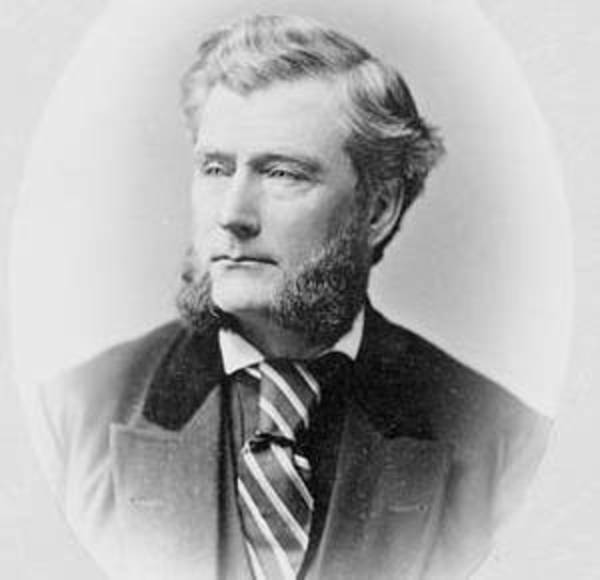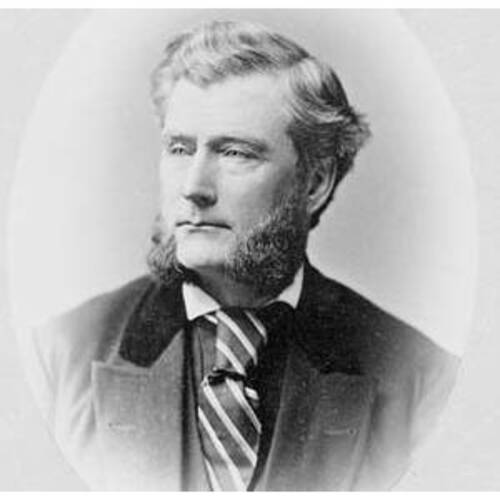As part of the funding agreement between the Dictionary of Canadian Biography and the Canadian Museum of History, we invite readers to take part in a short survey.

Source: Courtesy of Wikimedia Commons
OLIVER, ADAM, businessman and politician; b. 11 Dec. 1823 in Queens County, N.B., fourth son of John Oliver and Jeanett Armstrong; m. first 5 Dec. 1846 Elizabeth Grieve (d. 5 June 1866), and they had six children; m. secondly 13 June 1868 Ellen Rintoul, and they had four children; d. 9 Oct. 1882 at Ingersoll, Ont.
Educated in rural New Brunswick, Adam Oliver left for Westminster Township, Upper Canada, in 1836 and learned the trade of carpenter in London before moving to Ingersoll in 1850. Ingersoll was incorporated as a village in 1852 and it soon became a centre for a hardwood lumber trade as well as for wheat, farm implements, and, in the 1860s, cheese. Oliver benefited from the village’s early growth by establishing a building and contracting business. In 1853 he secured a $30,000 to $40,000 contract to build a depot at Niagara Falls for the Great Western Railway. Having acquired property in Ingersoll in the mid 1850s, Oliver proceeded to develop it, building a brick residence and a steam-powered planing mill, and setting up a lumber yard. By 1861 his various businesses employed 24 men.
Oliver was active in public affairs in Ingersoll from the time of its incorporation. He was elected to the first village school board in 1852 and to the village council in 1855, 1856, and from 1859 to 1863, serving as village reeve from 1859 to 1862; he was also warden of Oxford County in 1862. Following a bitter verbal attack by Oliver on Reeve John Galliford in 1856, village elections were contested by rival Oliver and Galliford slates. Oliver objected that Galliford’s handling of village affairs was secretive; however, control of the council would no doubt help his construction business and allow him to encourage the village’s development northwards towards the railway and his property. As reeve, Oliver argued against Ingersoll’s incorporation as a town, ostensibly out of fear that higher government costs would result but probably also still mindful of his own political interests: a popularly elected town mayor would have less control over his council than a village reeve who was the choice of council. His opposition to town status led to the defeat of the Oliver slate in 1863 and Ingersoll became a town in January 1865. Ironically, Oliver was elected Ingersoll’s first mayor in 1865 and 1866. While reeve and later as mayor, he also served Ingersoll as magistrate. In addition, Oliver was a member of the Independent Order of Odd Fellows from 1856 to 1865, captain of the volunteer Ingersoll Infantry Company from 1864 to 1866, and a liberal supporter of Erskine Presbyterian Church, although he was not a communicant until 1868.
In 1867 he formed the Adam Oliver Company in partnership with William Cairns Bell and Hugh MacKay Sutherland*, at which time extensive additions were made to Oliver’s mill and machinery at Ingersoll. With Bell assuming the management of the company, Oliver was free to contest Oxford South for the Reformers in Ontario’s first provincial election against James Noxon, a John Sandfield Macdonald* coalitionist. Successful in 1867, Oliver was re-elected in 1871, defeating the Conservative candidate Stephen Richards, an outsider. Aside from sponsoring legislation in 1868 to set standards for the manufacture of cheese and butter, both important products in his area, he did little for his constituency and abandoned it almost entirely in 1872, when he became preoccupied with business concerns in northwestern Ontario though he continued to reside in Ingersoll.
In 1871 fire destroyed a planing mill and lumber yard which his company had established in Orillia three years earlier. Transferring his equity from this venture to the Thunder Bay district, in 1872 he formed Oliver, Davidson and Company in partnership with Joseph Davidson, a Toronto lumberman and former Ingersoll resident, and Peter Johnston Brown and Thomas Wells, two Ingersoll lawyers. The company established the district’s first sawmill and planing mill near Fort William (now part of Thunder Bay, Ont.) in 1873. By 1874 it reportedly had rights to 40,000 acres and a total investment of $100,000 in the area. In January 1875 the dominion government announced that the largely uninhabited Fort William town plot was to be the Lake Superior terminus for the Canadian Pacific Railway. Oliver, Davidson and Company, holding 136 acres near the town plot and 42 lots in the town plot itself, was able to reap $12,410 from land sales to the government. In February the company acquired a $243,000 government contract to build a telegraph line from Fort William to Winnipeg. A $3,500 contract to build an engine-house in Fort William followed in September. In June 1876 the company contracted to operate the government telegraph line between Fort William and Rat Portage (Kenora).
Distressed by the failure to obtain the railway terminus for their own community, the inhabitants of nearby Prince Arthur’s Landing (later Port Arthur, now part of Thunder Bay) complained that the chief beneficiary of the dominion Liberal government’s contracts, Adam Oliver, was a Liberal member of the Ontario legislature. The result of their outcry was a Senate investigation into the land transactions. Its 1878 report stated that land valuation procedures had favoured property owners and the government had paid grossly inflated prices for land. Though the investigators of the Conservative-dominated Senate were obviously partisan and the testimony biased, Oliver was unquestionably embarrassed by a revelation about the generous compensation paid to his company for a hotel which was on land designated for the railway but which had been built after the government’s plans for the railway reserve had been announced. By 1879 Oliver’s active involvement in the northwest was over, although he retained business investments there until his death. Oliver’s reputation suffered again in 1882 when the report of the Royal Commission on the Canadian Pacific Railway presented circumstantial evidence indicating that his company’s Fort William to Winnipeg telegraph contract had been acquired through his influence with the Department of Public Works and in particular with its minister, Alexander Mackenzie*.
Compounding Oliver’s problems in the 1870s was the collapse of his political career. In 1874 he had resigned from the Ontario legislature because of a possible contravention of the “independence of parliament” act: Oliver, Davidson and Company had inadvertently sold timber to a buyer for the provincial government. Oliver was returned by acclamation in the by-election held later that year, perhaps because the opposition was content to forgo the by-election in anticipation of the forthcoming general election. He won only a bare plurality in the 1875 general election and was unseated after an investigation found bribery and corrupt practices among certain of his supporters. Retiring from provincial politics, and with his interest in Ingersoll reviving, Oliver ran in the municipal elections of 1877 for the post of first deputy reeve but was defeated by James Noxon. Elected to that position in 1880, he resigned 4 months later, after being stricken with paralysis, and died in 1882. After his death, his partnerships were dissolved and his properties converted into securities. Oliver’s wife inherited most of the estate, valued at $70,070.
Ingersoll Town Hall (Ingersoll, Ont.), Assessment rolls, 1880–82; Map of town of Ingersoll, 1905. Oxford County Surrogate Court (Woodstock, Ont.), no.1252, will of Adam Oliver, 26 Dec. 1882 (mfm. at AO). PAC, RG 31, A1, 1851, 1861, 1871, Ingersoll; 1842, 1851, Westminster Township. Can., Canadian Pacific Railway Royal Commission, Report (3v., Ottawa, 1882). Thunder Bay district, 1821–1892: a collection of documents, ed. and intro. [M.] E. Arthur (Toronto, 1973). Ingersoll Chronicle (Ingersoll), 1854–82. Oxford Herald (Ingersoll), 12 Jan. 1860–29 May 1862. Thunder Bay Sentinel ([Thunder Bay, Ont.]), 1875–79. Canadian biog. dict., I: 678–81. County of Oxford, gazetteer and general business directory, for 1862–3 . . . , comp. James Sutherland (Ingersoll, 1862). Oxford and Norfolk gazetteer, and general and business directory . . . , [comp. James Sutherland] (Woodstock), 1867. The Oxford gazetteer; containing a complete history of the county of Oxford, from its first settlement; together, with a full abstract of each census . . . , comp. T. S. Shenston (Hamilton, [Ont.], 1852). Pierre Berton, The national dream: the great railway, 1871–1881 (Toronto and Montreal, 1970), 229–39. George Emery, “Adam Oliver, Ingersoll and Thunder Bay district, 1850–82,” OH, 68 (1976): 25–43.
Cite This Article
G. N. Emery, “OLIVER, ADAM,” in Dictionary of Canadian Biography, vol. 11, University of Toronto/Université Laval, 2003–, accessed March 29, 2025, https://www.biographi.ca/en/bio/oliver_adam_11E.html.
The citation above shows the format for footnotes and endnotes according to the Chicago manual of style (16th edition). Information to be used in other citation formats:
| Permalink: | https://www.biographi.ca/en/bio/oliver_adam_11E.html |
| Author of Article: | G. N. Emery |
| Title of Article: | OLIVER, ADAM |
| Publication Name: | Dictionary of Canadian Biography, vol. 11 |
| Publisher: | University of Toronto/Université Laval |
| Year of revision: | 1982 |
| Access Date: | March 29, 2025 |



